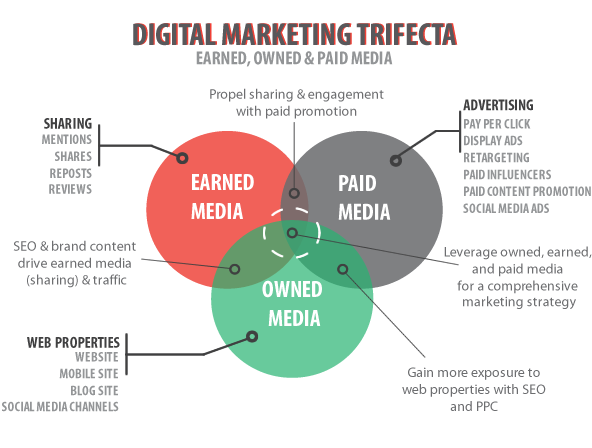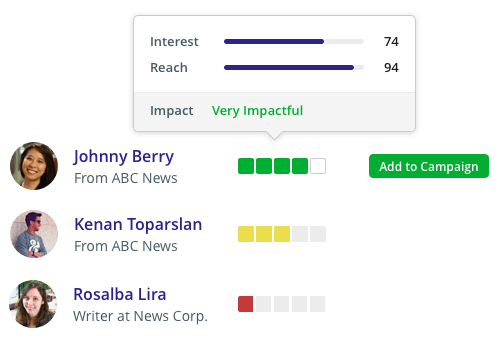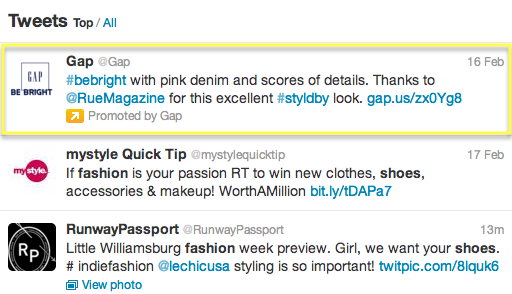
A Guide to Earned, Paid and Owned Media to Maximize Results
Learn what the difference is between the 3 types of media and how to maximise each opportunity.
Here’s a quick guide to what each type of media means and how you can maximize it for your PR efforts.
The Difference Between Earned, Paid and Owned Media

Image Source: Titan SEO
What is it?
This is the one most inline with traditional PR, some examples of earned media include:
- Magazine and newspaper articles.
- Customer reviews & testimonials.
- Social media mentions.
- Word-of-mouth recommendations (digital & in-person).
- Shares/Retweets of content created by your brand.
- Blog posts.
Earned media is the hardest kind of attention to get, and arguably the most valuable, because you can’t buy it and you can’t create it for yourself.
Here is a great summary of an earned media crisis from KFC and successful follow up campaign, plus the earned media once things turned around.
So what’s the actual value of earned media to your daily efforts? A study by inPowered and Nielsen found the following:
- 85% of consumers regularly or occasionally seek trusted expert content—credible, third-party articles and reviews—when considering a purchase.
- 67% of consumers agree an endorsement from an unbiased expert makes them more likely to consider purchasing.
- 69% of consumers like to read product reviews written by trusted experts before making a purchase.
How to maximize your earned media:
Leveraging earned media is actually pretty simple – do a great job with your owned and paid media properties, and the earned media will take care of itself.
I said simple, not easy! As you saw in the KFC example, you need to be able to handle the innate chaos that comes with not being in control of this media type.
It also takes time and resources to build a brand worth talking about, and you can’t rush it or force it. Start by investing in delighting your customers (underpromise, overdeliver).
Build a reputation for solving problems and creating valuable resources, and over time, happy customers will evangelize your brand to their friends and colleagues, and ultimately impact your bottom line.
What is it?
Paid media is just that – media exposure that you pay for. You can leverage paid media in the form of:
- Banner ads
- Sponsored blog posts
- Event sponsorships
- Paid search
- Social media ads
- Automatic press release distribution… the list goes on.
How to maximize paid media:
Paid media is often very expensive, and if you aren’t careful, you can wind up spending a lot of money for minimal (or even negative!) return on investment.
To make the most of your paid media buys, be very targeted with your spend – choose your audiences and publications carefully, put tracking mechanisms in place so you understand your cost per new lead, and most importantly, make sure you have a solid strategy in place to follow up with any leads you collect.
What is it?
Owned media includes all the media properties that you own and control. This includes:
- Your website
- Social media profiles
- Your blog, as well as any content you create.
- White papers
- Slide decks
- Infographics, and (online) press releases also count as owned media.
This is an example of owned media by R/GA.
How to maximize owned media:
There are two big advantages to owned media.
First, you have complete control over the content.
Second, it’s usually more cost-effective than other forms of media. Use your owned media presence to establish yourself as an expert in your field.
Create helpful, high-quality content on a regular basis (a blog is one of the best and easiest ways to get started), and use both owned and paid media channels to distribute this content to your target audiences.
If your content is truly valuable, it will also help you gain earned media via referrals and mentions in bigger publications.
BONUS: Below are some additional strategies to help you with your earned and paid media efforts.
Objectives
Is this a product announcement? Gaining some exposure for new product features? Educate some new research/data that you have found?
Understanding the KPIs or goals of your earned media campaign is vital to the design, layout and focus topics of the entire strategy.
Without having these clear objectives you are running the risk of putting together a press release that will sit on the giant world wide web and never be seen.
Target Demographic
Which of your media contacts will really appreciate and respond to your piece of content or press release?
Effective media relations and diligent note taking to understand what will resonate with your target audience will ensure that the language, imagery and tonality is inline with their expectations.

To understand effective media relations, check out our conclusive guide on the topic.
What Content is Consumed
For media and journalists there is rarely anything more important, in terms of content, than data and clear visualisations of said data.
But that’s a generalisation and it’s important to really think about your media contacts, refer to any additional notes you have made and zero in on what similar content they have published.
If you are reaching out to announce a new product feature, line up some examples of their previous product launch stories and see what information was included.
Distribution Plan
Earned media is a tough cookie and can take serious time and patience to gather any media pickups. However, there are plenty of opportunities out there to try and stimulate interest and coverage but you need to think ahead with your distribution channels.

First port of call would be to work alongside industry influencers. These individuals tend to dominate the industry and are a go-to source for industry insights and news before the large outlets add their spin to the story.
People take advice from industry influencers as they tend to have the edge on big publishers, they have the first and they either rave about it or they don’t. But if you want to add fuel to your distribution fire, start building relations with influencers.
Measure Your Efforts
It’s easy to say you should target X with content Y and use channel Z to succeed. But it’s never that easy and a big mistake that is often made is the lack of data collection or tracking.
Your latest press release may have succeeded or it may have not. Regardless, what could be done differently? Which of your media contacts showed no interest at all? Who picked up the piece and what benefits did it give you? All of these are vital to understanding future efforts.
Reach Out to Reporters
You probably do this on a daily basis, right? This comes with a little twist though. I’m talking about harnessing the new power of platforms such as:
- HARO,
- #journorequest
- Anewstip
- JournoRequests
The benefit of using these platforms is that you can find opportunities where older press releases may be of interest and use.
It’s relatively straightforward - you sign up to the mentioned platforms, fill in your filters, get an email with requests, reach-out with current or historic press releases with links to your newsroom.
Attend Trade Shows
Traditionally these are seen as less of a media exposure opportunity and more of a business focus. However, there are plenty of journalists that attend these events, generally they have special passes which you can try to hunt down but like the internet, you need something that sticks out.
Using trade shows to promote or discuss your content is a great way to gather an engaged audience via talks and discussions. Plus you have the opportunity of real-time Q&A sessions with interested journalists.
Do Something Worthy
Obvious really. But the lack of newsworthy content that is pushed out to journalists is alarming and the blame is placed on other areas.
Corporate social responsibility is a great way to get across not only your brands mission but the success stories that come with the efforts. Don’t run the risk of trying to slap together some minor pieces of news and try to push it out and expect results, there are plenty of websites and pages out there to fill that pointless void.
If your company has a dedicated newsroom that provides access to your media contacts and the general public, amplification of these press releases via social media is a great way to try and get additional coverage.
But if we refer back to the top of this article - know your audience and what content works.
LinkedIn Sponsored Updates
This is heavily based on the question - is this a place my target media contacts hang out? When you search for ‘journalist’ and go broad, you get ~999,692 results. Sounds like a Utopia, right?

Start shortlisting based on your target filters, whatever they may be. Get the list down to a much smaller number and try to get yourself into a niche level of numbers.
Running sponsored updates allows you to target specific professions and in some cases even with a remarketing list of an existing database. Be smart with your data and plug it into these platforms that give you the opportunity to do so.
Promoted Tweets
Twitter is the unofficial playground for journalists and the media. They can make requests and essentially get responses in real-time.
News has been written based on the tweets that a key individual has written so it makes sense to get involved with the platform.

One way to cut through the noise of it all is to go straight to promoted tweets. Again this provides great filtering, you can pinpoint who you want to target and even test headline ideas and images to see what works.